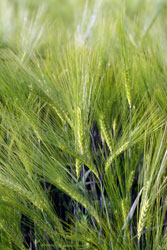Intelligent plant breeding
The presence of the FHB (Fusarium Head Blight) fungus in wheat and oats infects the plant and produces mycotoxins, which can easily infiltrate the food chain and impact upon food safety. In order to investigate what can be done about this, the FUCOMYR project was set up with the goal of developing novel tools for Fusarium resistant and toxin free wheat. Taking part in the project was a consortium, comprising of research institutes and SMEs in the wheat breeding sector. Experiments were conducted during three seasons and in five locations across Europe in order to characterise FHB resistance in the plants. The experiment used Fusarium inoculum which was applied by spraying directly onto the heads of the plant or by spreading Fusarium debris onto the soil surface. Mainly winter and some spring wheat genotypes from diverse sources were tested. Resistance was compared and both resistance against penetration of the ear (type I) and resistance against fungal growth subsequent to infection (type II) were monitored. Highly significant differences between FHB resistance lines were detected. The most promising resistance lines were used by private breeders in their crossing programs. Furthermore, the resistance data of the individual lines are available and can be compared by any third party The findings of this project will directly apply to the improvement of artificial inoculation techniques used up until now. In the long run this will mean the production of high quality wheat cultivars. The attainment of this would lead to European farmers becoming more competitive both in domestic and world cereal production markets. Healthier plants with less risk of mycotoxin infection will also contribute to a healthier diet for consumers.







